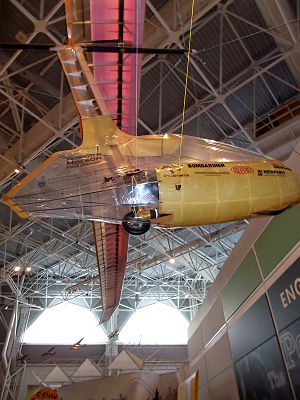UTIAS Snowbird
| Snowbird | |
|---|---|
 |
|
| The UTIAS Snowbird human-powered ornithopter on display at the Canada Aviation and Space Museum in Ottawa, Ontario, Canada. | |
| Role | Human-powered Ornithopter |
| National origin | Canada |
| Manufacturer | UTIAS Human-Powered Ornithopter Project |
| First flight | 31 July 2010 |
| Retired | 2 August 2010 |
| Status | retired |
| Primary user | HPO Project |
| Number built | 1 |
| Program cost | C$200,000 |
The Snowbird is a human-powered ornithopter that was built as a project of the University of Toronto Institute for Aerospace Studies (UTIAS). Snowbird was the first human-powered ornithopter to fly straight and level.
There have been several attempts throughout history of humans attempting to fly like a bird, under their own power. Leonardo da Vinci is frequently credited with creating the first design for a human-powered ornithopter in 1485. Since that time, many people have tried to make human-powered flight like a bird happen.
In 1991, the Fédération Aéronautique Internationale (FAI) awarded a “Diplôme d’Honneur” for the first remotely operated engine-powered ornithopter, which was developed by Professor James DeLaurier and UTIAS.
In 2006, the UTIAS Ornithopter No.1 flew. It required the assistance of a jet engine to take off, and its flapping wings were driven by an 18 kW (24 HP) gasoline engine.
The Human-Powered Ornithopter Project (HPO) started in the summer of 2006, as a spin-off of the University of Toronto Institute for Aerospace Studies (UTIAS) flapping-wing research program. The design was run in simulations to check feasibility before committing to construction.
The aircraft has a wingspan of 32 metres (105 ft) (comparable to a Boeing 737), and weighs 43 kilograms (95 lb). It cost $200,000 CDN (approx. $200,000 USD), not including donated material and time. It was built primarily with carbon fibre, balsa wood, basswood and foam. The pedals are connected to the wings through a system of pumps and pulleys. Snowbird does not have launch runup equipment, because of the need to limit weight, and requires a tow-assist at launch. The downward flap required 700 pounds-force (3,100 N). It was built under the supervision of professor James DeLaurier, a NASA alumnus. The craft was built under the University of Toronto's Human Powered Ornithopter Project. The team that built it was composed of five students. The name came about when, during testing on a snowy field, the cockpit became filled with snow.
...
Wikipedia
